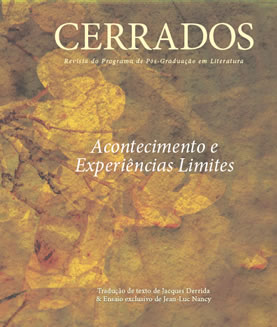The (in) communicability of the art at the rave crossroad
Keywords:
Literature. Society. Art. Madness. Delirium.Abstract
When an artist looks at a production, the basis of rationality and intuition established on aspects of culture and history of the subject are triggered. Similarly it happens with the reader: when faced before the finished product, whether a painting, a poem, a sculpture etc., our logical faculties are raised and try to give it an explained thought, however obscure it may seem to work of art, or else, we seek a logical explanation resorting to the criticism or the artist, if possible, to inquire about the genesis of the production. This is because we are moved by the criteria of logicality imposed by society. But what about the experience of writing that breaks with normal standards, establishing themselves in the borderline relation between sanity and madness? This is the motivation for this research. Thus, we aimed to analyze the experiences of some artists’ production in order to realize the (in) communicability of their works, from the relationship between art and delirium.
Downloads
References
ASSIS, Machado. O alienista. São Paulo: Ática, 1991.
BACHELARD, Gaston. A poética do espaço. São Paulo: Martins Fontes, 1993.
BODEI, Remo. As lógicas do delírio: razão, afeto, loucura. Trad. de Letízia Zini Antunes. Bauru, SP: EDUSC, 2003.
BORNHEIN, Izidoro. Os filósofos pré-socráticos. 14ª ed. São Paulo: Cultrix, 2007.
CARDOSO, Marta Resende. “Algumas reflexões sobre a autobiografia de Louis Althusser”. Disponível em: <http://www.fundamentalpsychopathology.org/art>. Acesso em: 28 mar. 2011.
EAGLETON, Terry. Teoria da literatura: uma introdução. Trad. de Waltensir Dutra. 6ª ed. São Paulo: Martins Fontes, 2006.
ESTEBAN, Claude. Crítica da razão poética. Trad. de Paulo Azevedo Neves da Silva. São Paulo: Martins Fontes, 1991.
FOUCAULT, Michel. “A vida dos homens infames”. In: ______. Estratégia, poder-saber. 1996. [Coleção Ditos & Escritos].
______. As palavras e as coisas: uma arqueologia das ciências humanas. 9ª ed. Trad. de Salma Tannus Muchail. São Paulo: Martins Fontes, 2007.
GOGOL, Nikolai. O diário de um louco. Disponível em: <http://amesadeluz.blogspot>. Acesso em 1º abr. 2011.
GOMES, Álvaro Cardoso. O poético: magia e iluminação. São Paulo: Perspectiva, 1989.
ISER, Wolfgang. “Problemas da teoria da literatura atual: o imaginário e os conceitos-chaves da época”. Trad. de Luiz Costa Lima. In: COSTA LIMA, Luiz. Teoria da literatura em suas fontes. 2ª ed. Rio de Janeiro: Francisco Alves, 1983. v. II.
LIMA, Barreto. Anotações para o cemitério dos vivos. In: OLIVEIRA, Edimar. Ouvindo Vozes: histórias do hospício e lendas do encantado. Rio de Janeiro: Vieira & Lent, 2009.
MAINGUENEAU, Dominique. O contexto da obra literária. Trad. de Maria Appezeller. São Paulo: Martins Fontes, 1995.
NETO, Modesto Carone. Metáfora e montagem. São Paulo: Perspectiva, 1974.
NINO, Maria do Carmo. “O Colecionador do Inatingível. In: COUTINHO, Fernanda (org.). A vida ao rés-do-chão: artes de Bispo do Rosário. Rio de Janeiro: 7 Letras, 2007.
NOGUEIRA, Lucila. O cordão encarnado: uma leitura severina. Recife: Bagaço,2010. v. 2.
OPALKA, Roman. Disponível em: <http://nga.gov.au/international/Catalogue/Detail>. Acesso em 02 fev. 2011.
PEREIRA, Vera Lúcia Felício. “Boitempo: a memória ruminante”. Cadernos de Letras, v. 1, nº 1. Belo Horizonte: PUC/MG, 1994.
PERRONE-MOISÉS, Leila. “Nenhures: Nenhum, nenhuma”. In: ______. Flores da escrivaninha. São Paulo: Companhia das Letras, 1990.
______. “Nenhures 2: Lá nas campinas”. Scripta. Belo Horizonte, v. 2, nº 3, 2º sem. 1998, p. 178-189.
ROSA, Márcia. “Antonin Artaud: de poeta do teatro da crueldade ao tradutor”. Disponível em: <http://redalyc.uaemex.mx/pdf>. Acesso em: 28 mar. 2011.
SALLES, Cecília Almeida. Gesto inacabado: processo de criação artística. São Paulo: Fapesp; Annablume, 1998.
SCHREBER, Daniel Paul. Memórias de um doente dos nervos. Rio de Janeiro: Paz e Terra, 2006.
Downloads
Published
How to Cite
Issue
Section
License
Proibida a reprodução parcial ou integral desta obra, por qualquer meio eletrônico, mecânico, inclusive por processo xerográfico, sem permissão expressa do editor (Lei n. 9.610 de 19/2/1998 )



